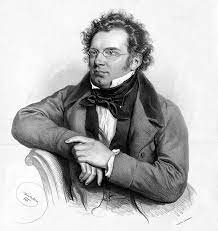Franz Schubert’s Symphony No. 8 in B minor
Program notes
Franz Schubert’s Symphony No. 8 in B minor, D. 759, commonly known as the Unfinished Symphony, is a musical composition that Schubert composed in 1822.
This Symphony is sometimes called the first Romantic symphony due to its emphasis on the lyrical impulse within the dramatic structure of Classical sonata form. Furthermore, its orchestration is not solely tailored for functionality, but specific combinations of instrumental timbre that are prophetic of the later Romantic movement, with wide vertical spacing occurring for example at the beginning of the development.

It consists of only two movements:
I. Allegro moderato
II. Andante
The first movement, in B minor, opens in sonata form, softly in the strings, followed by a theme shared by the solo oboe and clarinet.
The second subject begins with a celebrated lyrical melody stated first by the cellos and then by the violins. This is interrupted by a dramatic closing group alternating heavy tutti sforzandi interspersed with pauses and developmental variants of the G major melody, ending the exposition.
Unusually for sonata form, the development section begins with a quiet restatement of the opening melody in the subdominant, a tonality usually reserved for near the end of a sonata form movement somewhere in the recapitulation or coda, and rises to a prolonged climax in the same key, starting with a dramatic variant of the opening melody in the full orchestra with prominent trombones. The expected relative major of the tonic minor first appears only at the end of that climax, and then again for the second subject of the recap instead of much earlier, in the second subject of the exposition, as customary. The flutes and oboes then resume their melodic role at the end of that dramatic outburst, transitioning to the recapitulation.
The recapitulation consists mostly of orthodox sonata-form restatement of the themes, except that Schubert restates the melodious second theme in the relative key of D major instead of the usual B major. The dramatic closing section, however, does end in B major and leads to a coda in the tonic B minor. This recalls the opening theme for still another, final, dramatic reworking to pave the way for the emphatic concluding chords.
The second movement, in E major, alternates two contrasting themes in sonatina form. The lyrical first theme is introduced by the horns, low strings, brass, and high strings playing in counterpoint. The plaintive second theme, in minor, after four simple unharmonized notes in transition spelling out the tonic chord of the relative C♯ minor quietly by the first violins, begins in the solo clarinet in C♯ minor and continues in the solo oboe in C♯ major in an example of the major–minor juxtapositions that are a hallmark of Schubert’s harmonic language.
A dramatic closing theme in the full orchestra returns to C♯ minor but ends in D♭ major (the enharmonic equivalent of C♯ major). A short transition back to the tonic E major ushers in the recapitulation—notable for how it restates the second theme in the subdominant A minor begun by the oboe and continued by the clarinet.
The coda starts with a new theme that is simply an extension of the two-bar E major cadential figure that opens the movement. This gives way to the laconic triadic first-violin transition motto, which leads to a restatement of the first theme by the woodwinds in distant A♭ major followed by the motto again leading back to the tonic E major for a final extended transformation of the first theme, leading in turn to a final extended version of the opening cadential figure that reappears to close.
Franz Schubert
Franz Schubert was an Austrian composer of the early 19th century.
His talent as a composer of classical and romantic compositions was mostly ignored while he was alive but became significant only in the 19th century. Though his life was very short, he was a prolific composer who used to create many compositions in one single day. His works were greatly influenced by the writings of Goethe and were based mainly on the piano. His sonatas on the piano used melodies that had long lines instead of the traditional short themes and the romantic songs or ‘Lieder’ in the German language written by him put greater importance on the piano than on any other instrument as an accompaniment. He was not that well known in his early years as he was neither a literary person like many of the other composers during that period nor was a great performer or a famous conductor. But during the short time he was alive he wrote more than six hundred songs, nine symphonies, a large number of compositions for the piano and five masses. His masterpieces which brought enjoyment to many music lovers all over the world came to light only after he had passed away.
